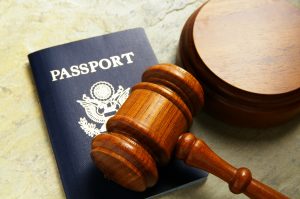 The Internal Revenue Service ("IRS") recently notified a major university that it is being audited, and as part of that audit requested copies of the employment agreements of the president of the university, the provost of the university, and the head coaches of the University’s football team, men’s basketball team, and women’s basketball team. This audit is a reminder to higher education institutions of the importance of making sure that all of their employment agreements and appointment letters fully comply with all of the tax and benefit requirements that apply to such agreements and letters. A failure to comply with these requirements could result in serious adverse tax and benefit consequences for the higher education institution, and for the employees covered by such agreements and letters.
The Internal Revenue Service ("IRS") recently notified a major university that it is being audited, and as part of that audit requested copies of the employment agreements of the president of the university, the provost of the university, and the head coaches of the University’s football team, men’s basketball team, and women’s basketball team. This audit is a reminder to higher education institutions of the importance of making sure that all of their employment agreements and appointment letters fully comply with all of the tax and benefit requirements that apply to such agreements and letters. A failure to comply with these requirements could result in serious adverse tax and benefit consequences for the higher education institution, and for the employees covered by such agreements and letters.
What Are Some of the More Important Tax and Benefit Issues That Should Be Reviewed in the Employment Agreements and Appointment Letters of Higher Education Institutions?
Among the more important tax and benefit issues that should be reviewed in the employment agreements and appointment letters of higher education institutions are the following:
- Compliance With the Deferred Compensation Requirements – The deferred compensation requirements in Sections 409A and 457(f) of the Internal Revenue Code ("Deferred Compensation Requirements") have a very broad scope, and affect numerous provisions in employment agreements and appointment letters that often are not considered to be deferred compensation. If an employment agreement or an appointment letter provides for any taxable payment to be made or any taxable benefit to be provided in a future calendar year, that taxable payment or benefit generally should be structured to be exempt from the Deferred Compensation Requirements when reasonably possible (if that is not reasonably possible, it should then be structured to comply with the Deferred Compensation Requirements). A failure to satisfy the Deferred Compensation Requirements could result in serious adverse tax consequences, including (1) possible taxation in the year an employment agreement or appointment letter is signed, including income that is scheduled to be paid or provided in a later calendar year, (2) a possible 20 percent tax on the applicable employee, (3) interest penalties in certain circumstances, and (4) corrected IRS Forms W-2 and Forms 990 in certain circumstances.
- Benefit Issues – If an employment agreement or an appointment letter provides any benefit that is in addition to, or exceeds, the benefits that generally are available to other eligible employees on campus, it is important to verify if (1) such benefit is allowed by the terms of the applicable benefit plan, and (2) whether offering such benefit will violate any nondiscrimination requirements under the Internal Revenue Code ("Code"). A violation of a plan’s terms or a Code nondiscrimination requirement could, in certain circumstances, result in coverage issues for the applicable employee, serious adverse tax consequences for the employee, and/or loss of a plan’s tax-favored status.
- Compliance With the "Reasonable Compensation" Requirements – The Code has excess benefit transaction provisions that require that no more than "reasonable compensation" be paid to certain persons who are in a position to exercise substantial influence over a covered tax-exempt organization. A failure to satisfy these requirements could result in excise taxes on the persons receiving "unreasonable" compensation, and on any officer, trustee or director who knowingly and willfully approved the "unreasonable" compensation. In egregious circumstances, the tax-exempt status of an organization could be revoked. Some states also have separate "reasonable compensation" requirements.
What Are Examples of Provisions In Employment Agreements and Appointment Letters That Are Subject To the Deferred Compensation Requirements?
Examples of provisions in employment agreements and appointment letters that potentially could be subject to the Deferred Compensation Requirements, and that generally should be structured to be exempt from the Deferred Compensation Requirements when reasonably possible (such structuring often will require additional language to be added to an employment agreement or appointment letter), include the following:
- Salary Provisions – a salary provision that provides for salary payments to be made in a future calendar year;
- Bonus or Incentive Compensation Provisions – a bonus or incentive compensation provision that could result in a bonus or an incentive compensation payment being paid in a future calendar year;
- Non-Exempt Benefits That Are Taxable – any non-exempt benefit that could result in a taxable benefit or payment being provided in a future calendar year, such as personal use of an automobile or personal use of a club membership (certain types of benefits are exempt from the Deferred Compensation Requirements, and nontaxable benefits are also exempt from the Deferred Compensation Requirements);
- Sabbatical Leaves – sabbatical leaves that result in taxable payments being made in a future calendar year;
- Certain Housing Benefits – any housing benefit that is taxable in a future calendar year (even though some housing can be provided on a tax-free basis if certain requirements are satisfied, the IRS has taken the position that some of the expenses that often are incurred with respect to such housing are personal expenses that are taxable);
- Expense Reimbursements That Are Taxable – any reimbursement of a business expense or other expense that is taxable and that could be paid in a future calendar year, such as a taxable reimbursement of spousal travel expenses (nontaxable expense reimbursements are exempt from the Deferred Compensation Requirements);
- Termination or Severance Payments – any termination or severance payments made in a future calendar year, such as payments owed after a termination without cause that are scheduled to be paid in a future calendar year (if a release agreement is required, the Deferred Compensation Requirements could also apply to the timing of payments made pursuant to that release agreement in certain circumstances);
- Other Provisions Providing Taxable Payments After Employment Ends – other provisions that provide taxable payments after employment ends and in a future calendar year (e.g., payments in a future calendar year for consulting services or for moving expenses); and
- Indemnification Provisions – indemnification provisions that provide for the possible reimbursement of certain expenses in a future calendar year.
Consideration should be given to adding a construction clause in each employment agreement (and in certain appointment letters when it would be helpful) that provides that the agreement or letter is intended to comply with any applicable Deferred Compensation Requirements, and should be construed in a manner that is consistent with the intent that the agreement or letter not be subject to the premature income recognition or adverse tax provisions of the Deferred Compensation Requirements. The IRS has indicated that it will give deference to such a construction clause in certain circumstances.
Each employment agreement and appointment letter should have language reserving the right of the university or college to withhold any required taxes with respect to any taxable payment or benefit described in the agreement or letter.
What Are Some of the More Important Benefit Issues That Should Be Addressed In Employment Agreements and Appointment Letters?
Among the more important issues that could arise when a benefit is being provided in in an employment agreement or an appointment letter is the extent to which the benefit is: (1) taxable; and (2) different than what is generally available to other employees on campus.
If a benefit is taxable and payable in a future calendar year, it generally should be structured to be exempt from the Deferred Compensation Requirements whenever reasonably possible. If it is not reasonably possible to structure the benefit to be exempt from the Deferred Compensation Requirements, it should be structured to comply with the Deferred Compensation Requirements.
If an employment agreement or appointment letter is providing a benefit that is different than what is generally available to other employees on campus, it is important to first check the terms of the applicable benefit plan, program, or policy to make sure the university or college has the authority to provide such a benefit (e.g., if an employment agreement or appointment letter is providing health or retirement benefits during a period when the applicable employee is not rendering any services, the terms of the applicable health or retirement plan should be reviewed to verify that benefits can be provided at a time when no services are being rendered). Such verification is especially important if the applicable benefit is being provided pursuant to a tax-favored retirement plan (a failure to follow the terms of a tax-favored retirement plan could jeopardize the tax-favored status of that plan) or an insured plan (e.g., a failure to comply with the terms of an insured health plan could result in an insurer refusing to provide coverage). It also is important to determine whether any different benefit that is being offered is subject to nondiscrimination requirements under the Code. Such nondiscrimination requirements generally preclude the applicable benefit being provided in a way that discriminates in favor of highly compensated employees, highly compensated individuals, or key employees (depending upon the applicable benefit). Examples of benefits that are subject to such nondiscrimination requirements include:
- tax-favored retirement plans (e.g., tax-sheltered annuity plans under Section 403(b) of the Code, and qualified retirement plans under Section 401(a) of the Code);
- self-insured health benefits (the Affordable Care Act imposed similar nondiscrimination requirements on insured health plans, but the IRS has issued a moratorium on those requirements until such time as it specifies otherwise);
- qualified tuition reduction benefits that provide free or discounted tuition benefits to employees, spouses of employees, eligible dependents of employees, and certain other persons if the requirements of the Code are satisfied;
- group-term life insurance benefits;
- pre-tax benefits under a cafeteria plan (including separate nondiscrimination requirements for dependent care assistance benefits and health flexible spending account benefits);
- educational assistance plans (under Section 127 of the Code);
- no-additional-cost service benefits and qualified discount benefits; and
- adoption assistance benefits.
What Are Some of the More Important Steps Covered Universities and Colleges Should Take To Comply With the "Reasonable Compensation" Requirements?
To the extent a university or college is subject to the "reasonable compensation" requirements under the Code, it will want to take the following steps, among others, to comply with those "reasonable compensation" requirements:
- identify which employees and other persons have the type of substantial influence necessary to be subject to the "reasonable compensation" requirements (such employees and persons are referred to in the statute as "Disqualified Persons");
- assemble appropriate comparability data regarding the total compensation and benefits being paid to similar persons at comparable organizations;
- arrange to have a properly authorized body of the university or college review the appropriate comparability data for each Disqualified Person, and, after confirming that no member of the authorized body has a conflict of interest, make a decision as to whether the total compensation and benefits being provided to each Disqualified Person are reasonable; and
- document, in a timely and proper manner, any decision made regarding the reasonableness of compensation paid to a Disqualified Person.
Any university or college subject to these "reasonable compensation" requirements generally should have written procedures in place that will help ensure that the required "reasonable compensation" analysis is done whenever there is an increase in compensation or benefits for a Disqualified Person. Certain state universities and colleges are exempt from these "reasonable compensation" requirements.
Some states have implemented reasonable compensation requirements, and to the extent those requirements are applicable they also will need to be taken into account.


 After hearing oral arguments earlier this week from attorneys representing the White House and the states of Washington and Minnesota, last night, the U.S. Court of Appeals for the Ninth Circuit unanimously upheld the U.S. District Court for the Western District of Washington’s February 3, 2017 issuance of a temporary restraining order prohibiting the federal government from enforcing President Trump’s Executive Order 13769, “Protecting the Nation From Foreign Terrorist Entry Into the United States” (EO 13769). As you know from our previous blog posts, EO 13769 suspends the entire refugee admission program for 120 days, the Syrian refugee program indefinitely and the entry of immigrants and non-immigrants from Iran, Iraq, Libya, Somalia, Sudan, Syria and Yemen for an initial 90-day period. For now, as a result of the Ninth Circuit’s decision, citizens from the seven restricted countries will be able to travel to the U.S. Despite the fact that the Ninth Circuit’s ruling refuses to reinstate EO 13769’s travel ban, it is important to note that this situation will continue to be fluid, and the Trump administration will very likely seek to appeal this latest decision. As such, we continue to advise that individuals from the seven restricted countries who are presently in the U.S. forego unnecessary international travel at this time. In addition, for those individuals from the restricted countries who have valid U.S. visas, who are presently outside the U.S. and who have the intent to return to the U.S., we recommend that they consider traveling to the U.S. while there remains an opportunity to do so.
After hearing oral arguments earlier this week from attorneys representing the White House and the states of Washington and Minnesota, last night, the U.S. Court of Appeals for the Ninth Circuit unanimously upheld the U.S. District Court for the Western District of Washington’s February 3, 2017 issuance of a temporary restraining order prohibiting the federal government from enforcing President Trump’s Executive Order 13769, “Protecting the Nation From Foreign Terrorist Entry Into the United States” (EO 13769). As you know from our previous blog posts, EO 13769 suspends the entire refugee admission program for 120 days, the Syrian refugee program indefinitely and the entry of immigrants and non-immigrants from Iran, Iraq, Libya, Somalia, Sudan, Syria and Yemen for an initial 90-day period. For now, as a result of the Ninth Circuit’s decision, citizens from the seven restricted countries will be able to travel to the U.S. Despite the fact that the Ninth Circuit’s ruling refuses to reinstate EO 13769’s travel ban, it is important to note that this situation will continue to be fluid, and the Trump administration will very likely seek to appeal this latest decision. As such, we continue to advise that individuals from the seven restricted countries who are presently in the U.S. forego unnecessary international travel at this time. In addition, for those individuals from the restricted countries who have valid U.S. visas, who are presently outside the U.S. and who have the intent to return to the U.S., we recommend that they consider traveling to the U.S. while there remains an opportunity to do so. On January 27, 2017 President Trump signed an Executive Order (“EO”) titled "
On January 27, 2017 President Trump signed an Executive Order (“EO”) titled " On November 14, 2016, the United States Citizenship and Immigration Services (“USCIS”) released a
On November 14, 2016, the United States Citizenship and Immigration Services (“USCIS”) released a  On November 28, 2016, New York State Governor Andrew Cuomo signed
On November 28, 2016, New York State Governor Andrew Cuomo signed  The Internal Revenue Service ("IRS") recently notified a major university that it is being audited, and as part of that audit requested copies of the employment agreements of the president of the university, the provost of the university, and the head coaches of the University’s football team, men’s basketball team, and women’s basketball team. This audit is a reminder to higher education institutions of the importance of making sure that all of their employment agreements and appointment letters fully comply with all of the tax and benefit requirements that apply to such agreements and letters. A failure to comply with these requirements could result in serious adverse tax and benefit consequences for the higher education institution, and for the employees covered by such agreements and letters.
The Internal Revenue Service ("IRS") recently notified a major university that it is being audited, and as part of that audit requested copies of the employment agreements of the president of the university, the provost of the university, and the head coaches of the University’s football team, men’s basketball team, and women’s basketball team. This audit is a reminder to higher education institutions of the importance of making sure that all of their employment agreements and appointment letters fully comply with all of the tax and benefit requirements that apply to such agreements and letters. A failure to comply with these requirements could result in serious adverse tax and benefit consequences for the higher education institution, and for the employees covered by such agreements and letters.